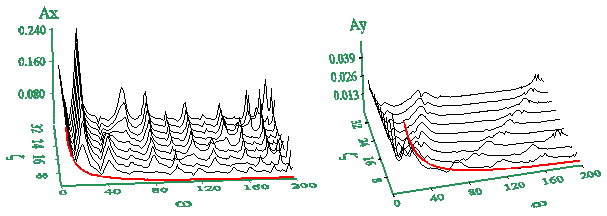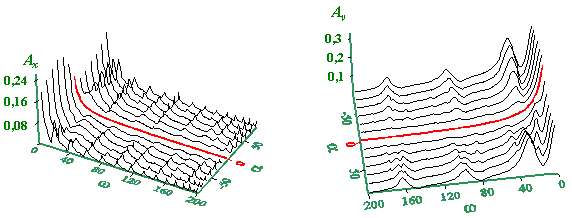| SELF |
98 |
| S.B.
Karavashkin, O.N. Karavashkina |

|
. 
Fig. 12. The amplitude-frequency characteristic for the
longitudinal (a) and transverse (b) components of vibrations in an elastic line having the
bend angle  =
60o , with respect to
the ratio =
60o , with respect to
the ratio  of the transverse and longitudinal stiffness coefficients. The model parameters: m
= 0,01 kg , F0 = 1 N , k = 15, slt
= 100 N/m ,
of the transverse and longitudinal stiffness coefficients. The model parameters: m
= 0,01 kg , F0 = 1 N , k = 15, slt
= 100 N/m ,  = 1,0 - 37,0 ,
= 1,0 - 37,0 ,  = 60o = 60o
|
In Fig. 12 we see the
amplitude-frequency characteristic of the longitudinal and transverse components of the
wave in an elastic line before the bend, with respect to  . At . At  = 1 (the nearest curve in the plot)
the amplitude-frequency characteristic has a hyperbolic form usual for ideal lines. With
growing = 1 (the nearest curve in the plot)
the amplitude-frequency characteristic has a hyperbolic form usual for ideal lines. With
growing  the
resonance peaks arise in the plots; their amplitude grows with growing the
resonance peaks arise in the plots; their amplitude grows with growing  which can cause
the local destructions on the quite stable general background. Some peaks in the middle
band arise only at large values which can cause
the local destructions on the quite stable general background. Some peaks in the middle
band arise only at large values  ; with growing ; with growing  the amplitude of some peaks first grows, then
smoothes. The peaks of transverse component become shifted with growing the amplitude of some peaks first grows, then
smoothes. The peaks of transverse component become shifted with growing  . This is caused
by growing . This is caused
by growing  tr in accordance with (32). It is
typical that despite the ideal pattern of elastic constraints, the amplitudes of resonance
peaks are finite. The peak locations for the longitudinal and transverse components do not
coincide too. In this connection, in such lines dependently on frequency either
longitudinal or transverse vibrations can prevail. Thus, in the propagation of a wave
having complex and especially continuous spectrum typical for solitary seismic waves, the
essential transformation of the wave shape takes place. A number of frequencies are
quenched in the wave travelling, and at the number of frequencies corresponding to the
resonance peaks the vibration amplitude abruptly increases; this process is not
synchronous for the longitudinal and transverse components. The smearing of the wave
packet caused by dependence of the phase delay (of the propagation velocity in that
number) on frequency adds to this. And taking into account that in the before-bend region
a complex superposition of standing and progressive waves takes place, the velocity
dispersion nonlinearly depends on the external excitation frequency. tr in accordance with (32). It is
typical that despite the ideal pattern of elastic constraints, the amplitudes of resonance
peaks are finite. The peak locations for the longitudinal and transverse components do not
coincide too. In this connection, in such lines dependently on frequency either
longitudinal or transverse vibrations can prevail. Thus, in the propagation of a wave
having complex and especially continuous spectrum typical for solitary seismic waves, the
essential transformation of the wave shape takes place. A number of frequencies are
quenched in the wave travelling, and at the number of frequencies corresponding to the
resonance peaks the vibration amplitude abruptly increases; this process is not
synchronous for the longitudinal and transverse components. The smearing of the wave
packet caused by dependence of the phase delay (of the propagation velocity in that
number) on frequency adds to this. And taking into account that in the before-bend region
a complex superposition of standing and progressive waves takes place, the velocity
dispersion nonlinearly depends on the external excitation frequency. |

a
b
Fig.
13. The amplitude-frequency characteristic of the longitudinal (a) and transverse (b)
components of vibrations in a line having different longitudinal and transverse stiffness
coefficients with respect to the bend angle  . The model parameters: m = 0,01 kg , F0 = 1 N , k = 15, slt
= 100 N/m , . The model parameters: m = 0,01 kg , F0 = 1 N , k = 15, slt
= 100 N/m ,  = 10 ,
= 10 ,  = 45o = 45o
|
For the amplitude-frequency characteristic with respect to
the bend angle of an elastic line, we see the similar pattern whose plots for the
longitudinal and transverse components in the before-bend region are shown in Fig. 13.
With  =
0 (the red curve in the middle part of the diagram) the amplitude-frequency
characteristic has a standard for an ideal line hyperbolic form even with =
0 (the red curve in the middle part of the diagram) the amplitude-frequency
characteristic has a standard for an ideal line hyperbolic form even with  > 1. With
growing > 1. With
growing  on
the amplitude-frequency characteristic, there arise the resonance peaks whose amplitude
increases with the growing on
the amplitude-frequency characteristic, there arise the resonance peaks whose amplitude
increases with the growing  , and their pattern depends not only on the value but also
on the sign of , and their pattern depends not only on the value but also
on the sign of  . As applied to the seismic processes, it means that the
abrupter transition from the flat country to the mountains is, and the abrupter the
curvature of a mountain arc is (the Pamir knot is a typical example), the more destructive
the earthquake consequences are. The same as in Fig. 12, the velocity of amplitude growing
is different for different peaks. Some peaks reveal only at large values . As applied to the seismic processes, it means that the
abrupter transition from the flat country to the mountains is, and the abrupter the
curvature of a mountain arc is (the Pamir knot is a typical example), the more destructive
the earthquake consequences are. The same as in Fig. 12, the velocity of amplitude growing
is different for different peaks. Some peaks reveal only at large values  , with
growing , with
growing  the low-frequency peak in Fig. 13 b coalesces with the next resonance peak, and the peaks
location on the amplitude-frequency characteristic of the longitudinal and transverse
components does not coincide.
the low-frequency peak in Fig. 13 b coalesces with the next resonance peak, and the peaks
location on the amplitude-frequency characteristic of the longitudinal and transverse
components does not coincide. |

